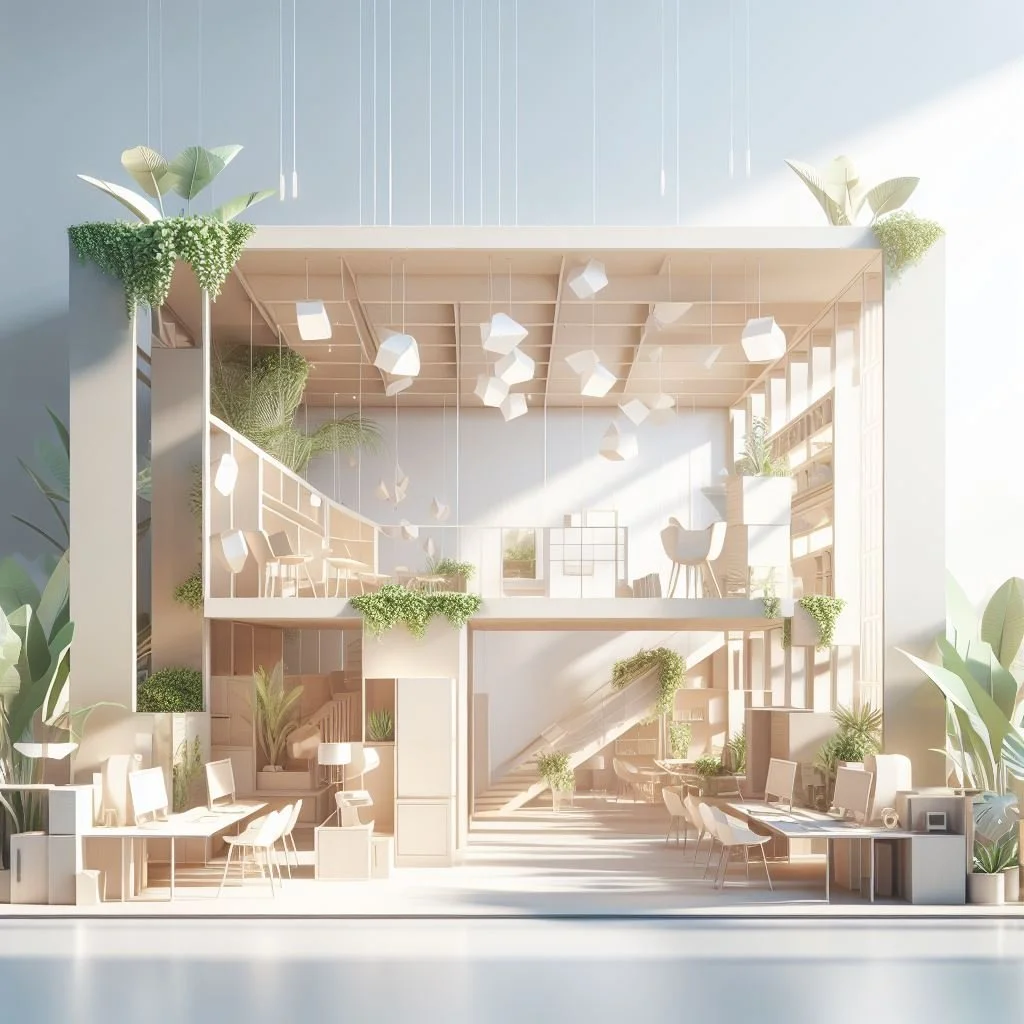How Sustainable Is Your Office Fit Out?
Introduction
Over the last few years, we've had the privilege of engaging with clients who, like us, are passionate about sustainability. However, sometimes, sustainability becomes a broad, undefined ambition without a clear path or measurable objectives. This is why we've created the POS EcoBlueprint Framework, transforming how we approach and embed sustainability into our commercial interior projects.
The POS EcoBlueprint Framework is a reflection of what we have learnt and is used to establish a clear plan for setting and achieving sustainability objectives whilst also delivering workspaces that exceed client expectations.
The Purpose of the POS EcoBlueprint Framework
The primary aim of the POS EcoBlueprint Framework is to assist our clients in embedding key sustainability considerations throughout their projects. It is a strategic tool that enables us to align good practice with decisions and to guide the transformation of workspaces into inspiring, wellness-oriented and productivity-enhancing spaces that minimise the negative effects on the environment. The benefits include:
Alignment with Sustainability Goals: It acts as a compass, ensuring every project sets its goals to be future-ready and environmentally considerate.
Comprehensive Guidance: The framework dives deep into sustainable best practices tailored for the commercial interior industry, offering clarity for our clients.
Legal Compliance: With a keen eye on regulations and certifications, the framework helps to clarify and allows our projects to meet local requirements and potentially set new benchmarks.
Long-term Impact: Championing the cause of viability and continuous improvement, the framework informs plans to ensure sustainability benefits can be achieved over the long term.
Enhanced Client Satisfaction: The demand for sustainability is ever-growing. Our framework enables us to take the lead, to advise, to guide and to enhance collaboration between our clients and our team.
The Scoring System Explained
Quantifying sustainability is challenging. However, our well-defined, transparent scoring system offers both precision and context.
Each of the ten core sections within the POS EcoBlueprint Framework focuses on a distinct aspect of sustainability, each with a specific purpose and benefits:
-
Purpose & Intent: To minimise energy consumption through efficient technologies and practices.
Benefits: Reduce operational costs, lower carbon emissions, and contribute to energy sustainability.
-
Purpose & Intent: To use sustainable materials and engage with responsible suppliers.
Benefits: Supports a sustainable supply chain, reduces environmental impact, and encourages responsible industry practices.
-
Purpose & Intent: To reduce, reuse, and recycle waste and to utilise waste-to-energy solutions.
Benefits: Minimises landfill usage, conserves resources and supports a circular economy.
-
Purpose & Intent: To minimise water consumption and waste through efficient technologies and practices.
Benefits: Reduce water costs, conserve water resources, and support responsible water management.
-
Purpose & Intent: To create a healthy and comfortable indoor environment.
Benefits: Enhances occupant well-being, improves productivity, and occupant satisfaction.
-
Purpose & Intent: To engage in socially responsible and community-oriented practices.
Benefits: Builds goodwill, strengthens community relations, and reflects positively on corporate social responsibility.
-
Purpose & Intent: To encourage innovative and sustainable design solutions.
Benefits: Enhances design quality, fosters innovation, and sets a project apart from competitors.
-
Purpose & Intent: To ensure compliance with relevant laws and to pursue sustainability certifications.
Benefits: Avoids legal issues, provides a competitive edge, and reflects a commitment to sustainability.
-
Purpose & Intent: To promote the well-being of occupants through design and operational practices.
Benefits: Enhances occupant health, reduces health-related absenteeism, and supports overall well-being.
-
Purpose & Intent: To ensure the ongoing sustainability and adaptability of the project.
Benefits: Ensures long-term viability, supports adaptation to future trends, and fosters continuous improvement.
Within each section, five pivotal concepts come into play. These concepts are evaluated on a scale:
0: Not addressed or not applicable
1: Partially planned/achieved
2: Fully planned/achieved
Thus, each section has a potential score of up to 10 points, leading to an aggregate possible score of 100 points across all sections.
Weighted Assessment: Not all sections carry the same weight in every project. To account for this, we've introduced a weighted mechanism. While a project can achieve up to 100 points based on individual section scores, these are weighted to give an overall sustainability score out of 10. A score of 10 indicates optimal sustainability alignment, and 0 would denote areas needing significant improvement.
Setting Targets & Monitoring Progress: Establishing a project’s ”planned scores” with a client allows us to plan the required actions and bring to life the environmental sustainability objectives and landscape of the project for stakeholders. As the project progresses, we monitor the planned actions against these target “planned scores” to eventually establish the ”achieved scores”. This provides a definitive scorecard and enables transparent reporting at the end of the project.
The Global Perspective on Sustainability in Commercial Spaces
As we seek to champion local sustainability efforts, it's useful to reflect on the main global themes that are underpinning the business case for investing in sustainable commercial spaces at environmental, social and economic levels, including to:
Conserve natural resources, reduce greenhouse gas emissions, minimise waste generation, and enhance biodiversity.
Lower operational and maintenance costs.
Elevate brand reputation and match evolving customer and investor expectations and demand.
Raise market values, occupancy rates and rental incomes.
Mitigate risk, reducing the potential negative impact or future consequences of not investing in sustainable solutions.
Deliver social benefits, improving the health, well-being and quality of life of the occupants and the community.
Enhance employee satisfaction, creativity and productivity.
The global momentum towards investing in the creation of sustainable commercial spaces is unmistakable. The evolving nature of sustainability underscores the importance of forward-thinking and adaptability, ensuring businesses remain at the forefront of eco-conscious initiatives.
Reference:
World Green Building Council (2021). "Beyond The Business Case: Why You Can't Afford Not To Invest In A Sustainable Built Environment".
A Greener Future Ahead
We've always been passionate about pushing boundaries and setting new standards. Launching the POS EcoBlueprint Framework marks a renewed dedication to our ethos of creating inspiring, eco-conscious spaces.
We're genuinely excited to bring the insights and guidelines from this framework to our client projects. We hope that every workspace we shape will benefit from a well-defined and measurable approach to sustainability.
As the POS EcoBlueprint Framework rolls out, we anticipate that it will evolve as we learn, and as more sustainable choices become available.
The Channel Islands have always been our home. This initiative is another step towards preserving its beauty and ensuring we contribute to a sustainable future.
Ready to Transform Your Workspace?
If you're as passionate about sustainability as we are, let's talk. Whether you're considering a new project or want to revamp an existing space, our team is eager to help you make your vision a reality. With the POS EcoBlueprint Framework, we're committed to creating workspaces that are not just beautiful and functional but also sustainable.






